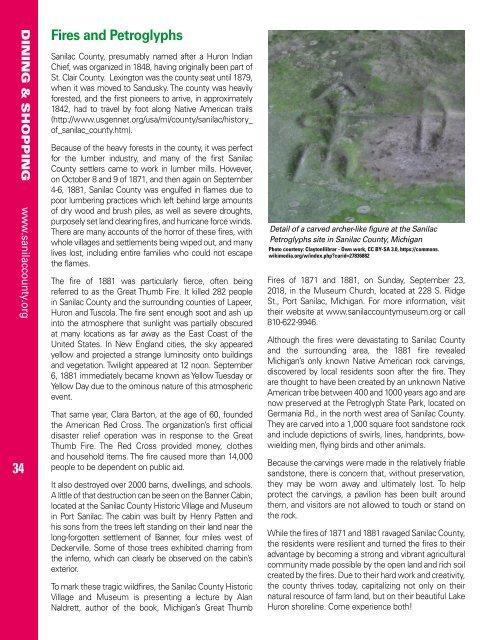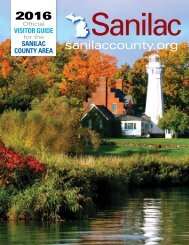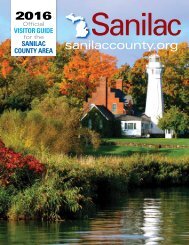Sanilac Guide 2018
Create successful ePaper yourself
Turn your PDF publications into a flip-book with our unique Google optimized e-Paper software.
34<br />
DINING & SHOPPING www.sanilaccounty.org<br />
Fires and Petroglyphs<br />
<strong>Sanilac</strong> County, presumably named after a Huron Indian<br />
Chief, was organized in 1848, having originally been part of<br />
St. Clair County. Lexington was the county seat until 1879,<br />
when it was moved to Sandusky. The county was heavily<br />
forested, and the first pioneers to arrive, in approximately<br />
1842, had to travel by foot along Native American trails<br />
(http://www.usgennet.org/usa/mi/county/sanilac/history_<br />
of_sanilac_county.htm).<br />
Because of the heavy forests in the county, it was perfect<br />
for the lumber industry, and many of the first <strong>Sanilac</strong><br />
County settlers came to work in lumber mills. However,<br />
on October 8 and 9 of 1871, and then again on September<br />
4-6, 1881, <strong>Sanilac</strong> County was engulfed in flames due to<br />
poor lumbering practices which left behind large amounts<br />
of dry wood and brush piles, as well as severe droughts,<br />
purposely set land clearing fires, and hurricane force winds.<br />
There are many accounts of the horror of these fires, with<br />
whole villages and settlements being wiped out, and many<br />
lives lost, including entire families who could not escape<br />
the flames.<br />
The fire of 1881 was particularly fierce, often being<br />
referred to as the Great Thumb Fire. It killed 282 people<br />
in <strong>Sanilac</strong> County and the surrounding counties of Lapeer,<br />
Huron and Tuscola. The fire sent enough soot and ash up<br />
into the atmosphere that sunlight was partially obscured<br />
at many locations as far away as the East Coast of the<br />
United States. In New England cities, the sky appeared<br />
yellow and projected a strange luminosity onto buildings<br />
and vegetation. Twilight appeared at 12 noon. September<br />
6, 1881 immediately became known as Yellow Tuesday or<br />
Yellow Day due to the ominous nature of this atmospheric<br />
event.<br />
That same year, Clara Barton, at the age of 60, founded<br />
the American Red Cross. The organization’s first official<br />
disaster relief operation was in response to the Great<br />
Thumb Fire. The Red Cross provided money, clothes<br />
and household items. The fire caused more than 14,000<br />
people to be dependent on public aid.<br />
It also destroyed over 2000 barns, dwellings, and schools.<br />
A little of that destruction can be seen on the Banner Cabin,<br />
located at the <strong>Sanilac</strong> County Historic Village and Museum<br />
in Port <strong>Sanilac</strong>. The cabin was built by Henry Patten and<br />
his sons from the trees left standing on their land near the<br />
long-forgotten settlement of Banner, four miles west of<br />
Deckerville. Some of those trees exhibited charring from<br />
the inferno, which can clearly be observed on the cabin’s<br />
exterior.<br />
To mark these tragic wildfires, the <strong>Sanilac</strong> County Historic<br />
Village and Museum is presenting a lecture by Alan<br />
Naldrett, author of the book, Michigan’s Great Thumb<br />
Detail of a carved archer-like figure at the <strong>Sanilac</strong><br />
Petroglyphs site in <strong>Sanilac</strong> County, Michigan<br />
Photo courtesy: Claytonllibrar - Own work, CC BY-SA 3.0, https://commons.<br />
wikimedia.org/w/index.php?curid=27836882<br />
Fires of 1871 and 1881, on Sunday, September 23,<br />
<strong>2018</strong>, in the Museum Church, located at 228 S. Ridge<br />
St., Port <strong>Sanilac</strong>, Michigan. For more information, visit<br />
their website at www.sanilaccountymuseum.org or call<br />
810-622-9946.<br />
Although the fires were devastating to <strong>Sanilac</strong> County<br />
and the surrounding area, the 1881 fire revealed<br />
Michigan’s only known Native American rock carvings,<br />
discovered by local residents soon after the fire. They<br />
are thought to have been created by an unknown Native<br />
American tribe between 400 and 1000 years ago and are<br />
now preserved at the Petroglyph State Park, located on<br />
Germania Rd., in the north west area of <strong>Sanilac</strong> County.<br />
They are carved into a 1,000 square foot sandstone rock<br />
and include depictions of swirls, lines, handprints, bowwielding<br />
men, flying birds and other animals.<br />
Because the carvings were made in the relatively friable<br />
sandstone, there is concern that, without preservation,<br />
they may be worn away and ultimately lost. To help<br />
protect the carvings, a pavilion has been built around<br />
them, and visitors are not allowed to touch or stand on<br />
the rock.<br />
While the fires of 1871 and 1881 ravaged <strong>Sanilac</strong> County,<br />
the residents were resilient and turned the fires to their<br />
advantage by becoming a strong and vibrant agricultural<br />
community made possible by the open land and rich soil<br />
created by the fires. Due to their hard work and creativity,<br />
the county thrives today, capitalizing not only on their<br />
natural resource of farm land, but on their beautiful Lake<br />
Huron shoreline. Come experience both!






